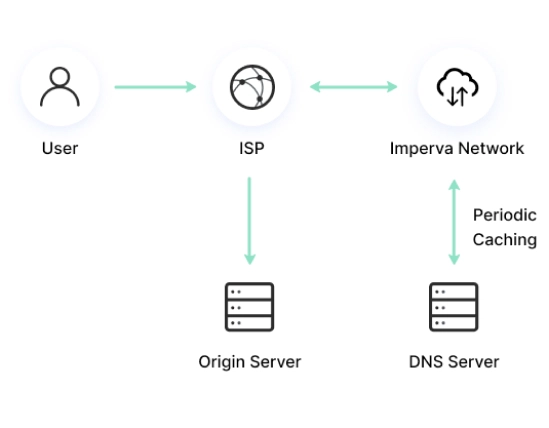What Is DNS Protection?
The Domain Name System (DNS) is a fundamental component of web navigation. DNS Protection is an integral part of cybersecurity, acting as a shield that guards your network and systems against cyber threats that exploit the DNS system. It controls and monitors outgoing DNS requests, blocking malicious domains, and safeguarding your network from harmful malware or phishing attacks.
The DNS translates IP addresses into human-readable addresses, for example it converts the IP 8.8.8.8 into the address www.google.com. DNS protection ensures that addresses mapped to IPs are legitimate and safe to interact with. It scrutinizes every DNS request, analyzes the risk associated with the destination, and allows or blocks access based on its safety assessment.
It’s important to understand that DNS protection isn’t just about blocking access to malicious websites. It also provides detailed insights into web usage, helping organizations understand their network activity better and identify potential vulnerabilities.

How DNS Works
Why Is DNS Protection Important?
Preventing Cyber Attacks
By controlling and monitoring DNS requests, DNS protection can prevent access to malicious domains and websites. It can protect against malware, ransomware, and phishing attacks that often start with a simple click on a harmful link.
Cybercriminals often exploit DNS to propagate malware and launch attacks. They trick users into visiting malicious websites or downloading harmful content, bypassing traditional security measures. DNS protection can successfully counter these tactics by blocking access to these dangerous domains at the DNS level, stopping the attack before it even begins.
Maintaining Business Continuity
Unexpected disruptions to business can lead to significant losses in revenue and damage to reputation. DNS protection plays a critical role in ensuring business continuity by safeguarding your network and preventing downtime caused by cyber-attacks.
In today’s interconnected world, even a minor disruption to your network can have cascading effects across your business operations. A successful cyber-attack can bring your systems to a standstill, disrupt communication, and halt business processes. By blocking access to malicious websites and domains, DNS protection helps keep your network secure and your business up and running.
Data Security
Protecting data from cyber threats is a top priority. DNS protection plays a crucial role in this regard by blocking access to malicious websites and domains, thereby preventing data theft or loss.
Cybercriminals often use DNS to propagate malware and launch attacks aimed at stealing sensitive data. These attacks can lead to significant data breaches, causing financial loss and damaging the organization’s reputation. DNS protection can effectively counter these threats by blocking access to malicious domains, preventing some types of data exfiltration.
Regulatory Compliance
Regulatory bodies worldwide are implementing more and more strict regulations to protect sensitive data from data breaches and cyber threats.Compliance with these regulations is mandatory for organizations to avoid hefty fines and reputational damage.
Many regulations require organizations to implement robust security measures to protect sensitive data. DNS protection, with its capability to block access to malicious websites and domains, is an effective security measure that can help organizations meet this requirement. DNS protection also provides detailed logs of network activity, which can demonstrate to regulatory bodies that the organization has taken appropriate steps to protect sensitive data.
Common Types of DNS Attacks
DNS Spoofing
DNS spoofing, also known as DNS cache poisoning, is a type of cyber-attack where the attacker corrupts the DNS cache data to redirect users to malicious websites. The attacker manipulates the DNS response to a user’s request, leading them to a fake website instead of the intended one.
This type of attack is particularly dangerous because the user might not realize they are on a malicious website. They might unknowingly enter sensitive information, such as usernames, passwords, or credit card details, which the attacker can then steal.
DNS protection can effectively counter DNS spoofing by verifying the authenticity of DNS responses. It can detect if the response has been tampered with and block access to the fake website, thereby preventing data theft.
DNS Hijacking
DNS hijacking is another common type of DNS attack where the attacker takes control of the DNS server and redirects the user to malicious websites. The attacker alters the DNS settings of a device or network, causing all DNS requests to be routed to a rogue DNS server controlled by the attacker.
DNS hijacking can lead to significant data breaches as the attacker can control the websites the user can access. They can direct the user to fake websites to steal sensitive information or propagate malware.
DNS protection can thwart DNS hijacking by monitoring DNS requests and blocking access to malicious domains. It can also detect abnormal changes in DNS settings and alert the network administrator, enabling them to take corrective action promptly.
DNS Tunneling
DNS tunneling is a technique used by attackers to bypass network security measures and gain unauthorized access to a network. The attacker encapsulates data within DNS queries and responses, using the DNS protocol as a covert communication channel.
This type of attack is challenging to detect as it exploits legitimate protocols, making it blend in with normal network traffic. However, DNS tunneling can lead to data breaches and unauthorized access to network resources.
DNS protection can counter DNS tunneling by analyzing DNS traffic for abnormal patterns. It can detect suspiciously large DNS queries or an unusually high number of queries, which are typical indicators of DNS tunneling.
DNS Amplification
DNS amplification is a type of distributed denial of service (DDoS) attack where the attacker exploits the DNS protocol to overwhelm a network with traffic, causing it to become unavailable. The attacker sends a small DNS query with a forged IP address to a DNS server, which then sends a much larger response to the victim’s network, hence the term ‘amplification’.
This type of attack can cause significant network disruptions, leading to downtime and loss of revenue. DNS protection can help mitigate DNS amplification attacks by monitoring DNS traffic and detecting abnormal patterns. It can block suspicious DNS queries, preventing them from reaching the DNS server and causing an amplification attack.
5 Ways to Protect Your DNS
Here are five easily available methods you can use to protect your DNS systems. In the next section, we’ll discuss dedicated DNS protection solutions, which provide more advanced capabilities.
1. Regular DNS Audit
A regular DNS audit is an integral part of DNS protection. This involves routinely checking the DNS settings and records to ensure they are correct and haven’t been tampered with. Regular audits can help in identifying any anomalies or changes that could potentially open up vulnerabilities or expose your system to attacks.
Moreover, a DNS audit can also help in identifying outdated or unnecessary DNS records that can be cleaned up, thus improving the efficiency of your DNS system. Regular DNS audits are not just about identifying and fixing problems, it’s also about maintaining an optimally functioning DNS system.
2. DNSSEC (Domain Name System Security Extensions)
DNSSEC adds an additional layer of security to the DNS by verifying the authenticity of the DNS responses. This is achieved through a system of digital signatures and public key cryptography.
DNSSEC ensures that the DNS responses are legitimate and haven’t been tampered with, protecting users from attacks like DNS spoofing, where an attacker can redirect a user to a malicious website. Implementing DNSSEC can significantly enhance the security of your DNS system, providing a much-needed shield against DNS-based attacks.
3. DNS Firewall
A DNS firewall is a security measure that monitors and controls DNS traffic, blocking any malicious activities or threats. It operates by using threat intelligence data to identify and block known malicious domains.
A DNS firewall can prevent malware from communicating with its command and control servers, block phishing attacks, and stop data exfiltration attempts. By implementing a DNS firewall, you can greatly enhance DNS protection and prevent a wide range of DNS-based threats.
4. Intrusion Prevention Systems (IPS)
An intrusion prevention system or IPS is a network security tool that monitors network traffic for potential threats and responds in real-time to prevent them. IPS can help in preventing various types of attacks, including DNS-based attacks.
An IPS can be particularly effective in preventing DNS tunneling, where an attacker uses the DNS protocol to bypass network security controls and exfiltrate data or establish a remote control channel. By implementing an IPS, you can add an additional layer of DNS protection and safeguard your network from various threats.
5. Anomaly Detection Systems
Anomaly detection systems are a type of security technology that uses machine learning and statistical analysis to identify unusual behavior or patterns in network traffic. In the context of DNS protection, anomaly detection systems can help in identifying potential DNS attacks or threats that deviate from the normal behavior of the DNS traffic.
For instance, an unusually high number of DNS queries or a sudden increase in the size of DNS responses could indicate a potential DNS-based attack. An anomaly detection system can detect such unusual patterns and trigger an alert, allowing for timely intervention and mitigation of the threat.
DNS Protection Solutions: Key Capabilities
Here are some of the key capabilities of dedicated DNS protection solutions, which can provide better protection compared to the basic measures covered above.
Phishing and Malware Protection
Phishing and malware are among the most common threats faced by internet users today. DNS protection services and solutions offer capabilities to block phishing attempts and malware communication.
By blocking malicious domains and URLs, DNS protection can prevent users from inadvertently accessing phishing sites or downloading malicious content. This can significantly enhance the overall security posture and protect users from falling victim to phishing or malware attacks.
Botnet Protection
Botnets are networks of compromised devices controlled by an attacker. These can be used for a variety of malicious activities, including DDoS attacks, spamming, and data theft. DNS protection services and solutions offer capabilities to detect and block botnet communication.
By monitoring the DNS traffic for patterns indicative of botnet communication and blocking communication with known botnet command and control servers, DNS protection can effectively neutralize the threat posed by botnets.
Content Filtering
Content filtering involves blocking access to specific types of content based on predefined policies. By blocking access to certain categories of websites or specific URLs, DNS protection can help in enforcing acceptable use policies, preventing access to inappropriate or harmful content, and enhancing security by blocking potentially malicious sites.
Ad Blocking
In addition to blocking malicious content, DNS Protection services and solutions can also block unwanted ads. This can enhance the user experience by reducing distractions and improving page load times.
Moreover, since some ads can also carry malicious content, ad blocking can also contribute to enhancing security. By blocking intrusive and potentially harmful ads, DNS Protection can provide a safer and more pleasant browsing experience.
Typo Correction
Typo correction is a somewhat underrated but highly useful capability offered by some DNS Protection services and solutions. This feature automatically corrects typos in domain names, preventing users from landing on incorrect or potentially harmful websites.
By correcting common typing mistakes, DNS Protection can prevent users from inadvertently accessing malicious sites, thereby enhancing security. Moreover, typo correction can also improve user experience by helping users reach their intended destination faster and with less frustration.












